
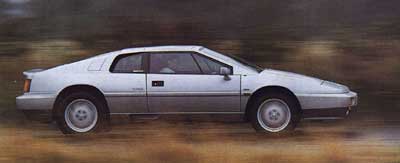
Lotus Esprit
Body & Soul
On paper, the '88 Lotus Esprit is simply
a new body fitted to the old car.
Truth is, it's a sports car of character and style fit to be compared to
the best from Porsche and Ferrari.
FOR ONCE, A MANUFACTURER has understated the importance of its new car. Lotus's chief executive, Mike Kimberley, was quite adamant at the press launch of the '88 Esprit that we were being shown a rebodied car, rather than a new one. It was an improvement, an evolution. A stepping stone to a new Lotus range. In fact, the new Esprit is far more than that.
The changes – totally new body, new interior and some worthwhile suspension modifications – have transformed the mid-engined Lotus from an ageing and often annoying companion into a competitive supercar for the 90's. The Esprit is back on course as a real alternative to a 911, or a Ferrari GTB. Gone is that sharp-edged body, which look great when Giugiaro first designed it but has been looking every one its 12 years of age recently. The edges are softer, the nose and tail tidier, the shape better integrated. The body is the work primarily of Lotus Design's Peter Stevens. Every panel is new. The glass area – the windscreen and side windows look like those of the old Esprit – is also different.
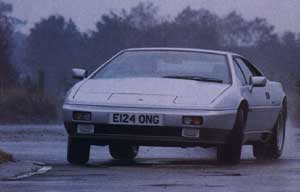
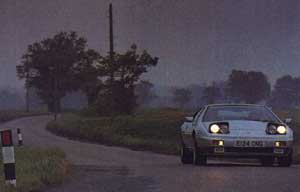
Not only do the body panels look different; they are made in a different way. The old Esprit featured a hand-laid glassfibre body. The new car's clothes are produced using Lotus's vacuum-assisted resin injection (vari) glassfibre process, which is said to improve panel finish and increase ease of production. It also has the significant advantage of greatly improving the car's torsional rigidity, because it has far greater strength. The new vari body is bolted onto the (unchanged) backbone chassis, as it was before. But the vari design, and the use of Kevlar in certain high-stress areas, has helped increase the torsional rigidity of the Esprit by a massive 22 per cent. This is probably the most significant change to the whole car. On the road, that extra rigidity is immediately noticeable.
Also immediately evident – and even more gratifying – is the new interior. The old Esprit's was always awful. It had that draft dash, which had the switch-gear out on side binnacles; it had instruments that the steering wheel obscured; it had leather upholstery on the dash and doors that was supposed to look creased, but simply looked badly fitted; it had terrible ventilation; the reflections on that large flat windscreen were so bad that forward visibility was occasionally non-existent and the cockpit was a tight fit for anybody much over six feet tall. Things still aren't perfect inside, but they are a lot better.
The dash is new: it's much cleaner and more conventional, and all the better for that. The switches are new – they are now push buttons, from the Maestro, replacing the old stumpy lever switches borrowed from the TR7. The instruments are white-on-black analogues, from VDO. The new three-spoke steering wheel fitted to the Esprit Turbo (the normally aspirated Esprit continues with the old go-kart like two-spoke wheel) helps improve the visibility of the instruments, as does the improved placement. Gone is the creased leather effect; proper tautly fitted cowhide is used instead. There is a bit more leg, head, and footwell room, and the re-designed seats are wider.
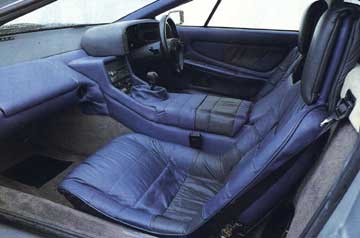
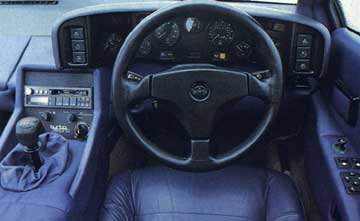
New body design much cleaner than old square-edged shape; better Cd too. Every panel new. Interior also much improved. Instruments clear, facia more attractive, switchgear better. But still not very roomy.
The Esprit is still a cramped car, through. The new screen, although mildly curved rather than being as flat as a cupboard door, still shows you the top of the dash on a bright day, when all you want to see is the road. And the ventilation, although revised, is still feeble. You'll need the £1050 optional air-conditioning system, if you are to enjoy life inside an Esprit on a warm day.
Mechanical changes are minimal. The suspension – whishbones front and rear – is the same on paper, but spring and damper rates have been revised. The 2.2 litre four-cylinder aluminium alloy engine is unchanged, apart from the use of a watercooled turbocharger and integral (rather than separate) wastegate. Maximum power is 215bhp (up 5.0bhp on the old Esprit Turbo) and maximum torque 220lb ft. The most important mechanical development is use of a five-speed gearbox from the Renault GTA, in place of the Citroen SM unit. Also, the rear disc brakes have been moved outboard. That has marginally increased unsprung weight. Nonetheless, the use of lighter Lotus-designed alloy wheels more than compensates: overall, the unsprung weight has been reduced.
The lower unsprung weigh marginally improves handling; so, undoubtedly, do the tweaks to the springs and dampers. But what really helps, I'm convinced, is the greater structural rigidity. The '88 Esprit Turbo is a far more competent handler than the old car. For all the raving that went on about the old Esprit's handling and responsiveness, it's a car that I have never felt truly comfortable driving quickly. As with many mid-engined cars, the Esprit is inclined to be twitchy on the limit. That wasn't the problem. The problem was that when the Esprit got crossed up, it tended to snap suddenly and unpredictably. Not so the new car.
Its much greater rigidity means that the wheels are more inclined to point in the right direction, when things do get crossed up. And that means the car is less likely to deceive you. A day spent driving the Esprit – both Turbo and normally aspirated – on a wet Hethel test track, and on surrounding Norfolk roads, turned out to be a day of sheer driving delight. At Hethel, the car could be powered around tight bends on opposite lock – and be held in glorious, easily controllable, power slides. This was an Esprit Turbo that could be thrown around with gusto; it would behave as requested and, even if it overstepped the mark, be brought safely back into line. The suddenness has been replaced by sweetness. The Esprit is now a superbly balanced car. The ride, and tautness of the car over bumps is excellent – and substantially improved, too. Again, the structural strength of the car is a major factor.
The Esprit still has wonderful steering. Although it's very firm at low speed – you really have to use your arm and shoulder muscles to heave that wheel about – the steering has a sharpness, a razor edge, that just isn't found on many cars today. It is always heavy – even at speed, you can feel the front wheels resisting change from the straight-ahead. Yet that firmness is allied to a responsiveness, and to such sensitivity, that the Esprit always feels alive. The car is never inert, never dull. It feels like a racing car, thanks to that direct steering, even at low speed.
In fact, it feel like a racing car even when you first lower your hips over the wide sill, and settle down between the sill and the wide and high centre console. It's the lowness of the seating position which does it, and the slight felling of claustrophobia. You feel tightly packed; no space is wasted. The steering wheel is little – although, on the Turbo, not as small as it was before – and is sited quiet high, so that you have to reach up to grab it. The new steering wheel, another product of Lotus's burgeoning design division, looks great and its thick leather covered rim feels good. And what's this? An Esprit with instruments that you can see! Don't get too excited, though. Sure enough, tucked away behind the wheel rim, are the fuel gauge, the ammeter and part of the tachometer. The switchgear, and cabin fittings, are a class above those of the old Esprit. Those old Austin 1800 door handles are still there, though. Apparently, altering them would have involved costly type-approval changes.
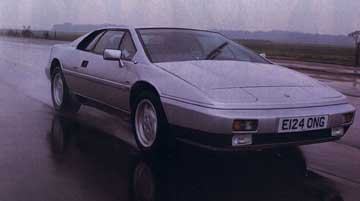
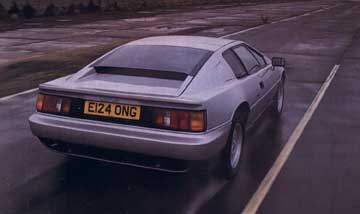
Turbo model is more aerodynamic than normal Esprit. Handling of new car more predictable than before, owing to better rigidity and suspension tweaks. Turbo four-cylinder develops 215bhp.
The Turbo 16-valve twin-cam engine starts with a more subdued bark than before, and settles down to a muted, slightly uneven idle. It's a quieter cabin, owing to superior firewall insulation. On a long run, the engine drone will undoubtedly be tiring – but what mid-engined car's exhaust note is not? The car, as a whole, is considerably quieter than its predecessor. Not only is the engine better isolated from the cabin, but Lotus has made a big effort to improve the old Esprit's dreadful wind noise. Reducing the size of the shutlines has helped; so has secondary door seals, and steel window frames. The new car is also vastly more aerodynamic than the old one, although the publicity blurb will tell you otherwise. Lotus has maintained that the old Esprit has a Cd of 0.33 – which tied in well with the company's high-tech image. Sources tell me the Cd was, in fact, well over 0.4. The apocryphal Cd served Lotus well when the old Esprit was in production; it has proved somewhat embarrassing at new model time. The new Esprit has a (true) Cd of 0.33. The new car is much quieter than the old howler was at 80mph-plus, but still generates more windnoise than most modern machinery.
The turbo engine is still as good as ever. The blown motor dates back to 1980, yet is still one of the best turbocharged units around. It's the absence of lag which makes it special: the almost instantaneous throttle response, the feeling that it delivers immediately on request. It is not a massively powerful engine: a normally aspirated 911 feels quicker. Yet the Esprit Turbo is still a fast car. The blurb claims 152mph top speed, and 5.3 sec for the 0-60mph sprint. The latter sounds a bit optimistic, but a friend at Lotus tells me the company has seen more than 160mph during tests. The brakes are up to the performance: the moving of the rear discs (and perhaps a few other secret tweaks) have improved the feel of the middle pedal, although the effort required to stop the car is still high. The footwell, although marginally wider, is still cramped. The pedals are bunched so close together that those with wide feet will find this an awkward car to drive.
The new gearbox is an improvement. The change is lighter and easier to master than the old Esprit's, but it is still too indirect. The problem is particularly acute during downshifting, when crossing the gate. The Renault GTA, which supplies the box, has a better shift. The gearknob which sits on top of the little lever is also awful; it's a Renault device, as seen on the R5GT Turbo, and looks like it's covered in a black elastoplast. Lotus is considering another more elegant design.
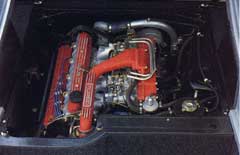
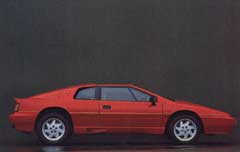
I drove the Esprit Turbo far more than I did the naturally aspirated car. And that was a pity, for in many ways the non-turbo car is the sweeter of the pair. Freed from the compromises always inherent in a turbo, the Esprit has sharper throttle response than its more powerful brother. As such, it's an easier car to control on the throttle. Lotus claims a 0-60mph time of 6.5, and a top speed of 138mph.
It looks just the same as the Turbo, save for the absence of front sport lights and the lack of the glass shroud over the rear screen. Removing the glass shroud does damage the Cd (which increases to 0.36 in the non-turbo car), but, more important, it increased rear visibility on a wet day. The glass collects rain water, even on the move.
Not surprising, Lotus has taken the opportunity to jack up the price of the Esprit, now that there's a new model. The normally aspirated car goes up by just over £2,000, to £22,950. The Turbo jumps by about £3,000, to £28,900. They still represent value for money. More important, the Esprit represents a sizeable leap forward by Lotus. It's a more mature car, a much more balanced car. It will do Lotus's reputation as a serious rival to Porsche and Ferrari a powerful lot of good.
|
|